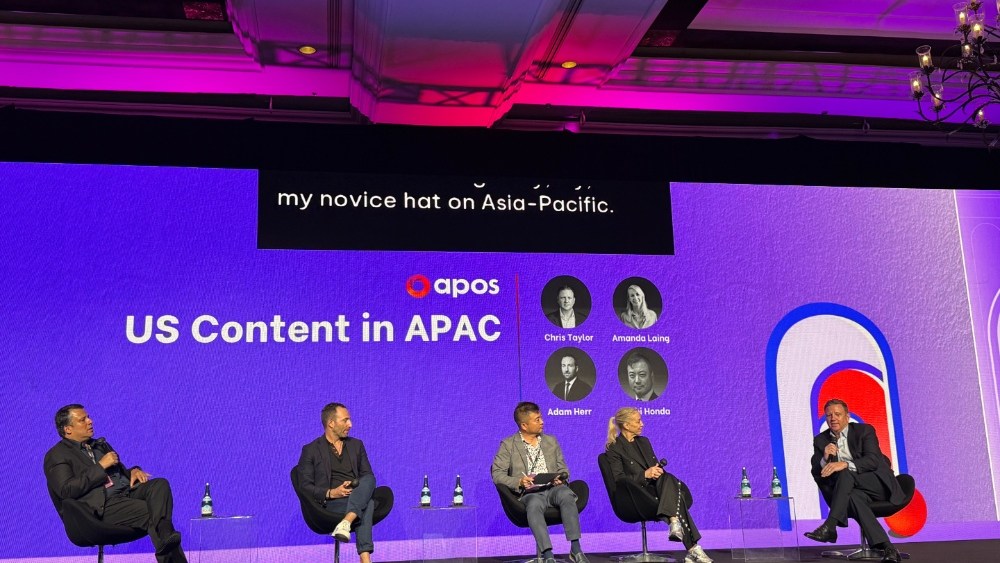Despite the surge in local content production across Asia-Pacific, Hollywood studios and streaming platforms are finding renewed strength in the region through strategic partnerships and localization efforts, according to executives speaking at the APOS summit.
The panel, featuring Chris Taylor, MD APAC for NBCUniversal Television Distribution; Amanda Laing, MD streaming and broadcast at Nine Entertainment; Adam Herr, senior VP of distribution APAC at Sony Pictures Entertainment; and Toshi Honda, COO of Japanese streamer U-Next, painted a picture of a complex but promising landscape for U.S. content.
“There’s definitely a recognition that there is a cohort that you still need to service that really wants to see the best content,” said Taylor, who recently took on his APAC role. “The bigger these services get, despite the fact that you’ve got local content first, we feel very good about the Asian region.”
The executives highlighted the stark differences between markets within the APAC region. “Every territory, every country, is different,” Herr explained. “What works in Japan is different than what works in Korea, different than what works in India.”
Australia continues to be a robust market for Hollywood content, with Nine Entertainment’s Laing noting that “50% of our new customers come in to watch big premium scripted content” on their subscription streaming service Stan. She cited shows like “Breaking Bad” and “Yellowstone” as key drivers.
However, the strategy varies across platforms. “Each part of our business wants different types of U.S. content,” Laing said, explaining that their free-to-air and multi-channel services require different programming approaches than their premium streaming offerings.
Both Sony and NBCUniversal emphasized the importance of localization in driving engagement. Sony has invested heavily in dubbing content for the Indian market, making movies available not just in the English and Hindi languages, but also in Tamil and Telugu.
“We’re finding that the engagement is much higher because we’re providing audiences with content that they can watch and understand more easily,” Herr said. “It’s an investment for the future to make sure that Hollywood is still really healthy.”
Taylor echoed this sentiment, noting that “localization to the extent we can is absolutely critical,” while expressing hope that AI technology will make the process more cost-effective.
In Japan, U-Next’s Honda highlighted the continued power of blockbuster films in both theatrical and streaming contexts. “Blockbusters generate the revenues and also acquire new subscribers,” he said.
Honda noted that films like “Mission: Impossible” and other major franchises continue to drive significant subscriber acquisition, while HBO series help with retention strategies.
The executives emphasized the growing importance of digital marketing and short-form content across platforms like YouTube and TikTok. Sony has invested in over 12 YouTube channels in India, generating over 400 million views for “Shark Tank” clips and episodes, and over 100 million views for their “Who Wants to Be a Millionaire” adaptation.
“We’re competing with not each other, but just where people spend their time,” Herr explained. “Reaching them on TikTok, investing in building YouTube channels where we put our content as well, it just helps engagement.”
All panelists stressed the importance of deeper strategic partnerships moving forward. “We don’t view it as just a transaction where we sell you something,” Herr said. “We want to make it successful.”
Laing reinforced this sentiment, reflecting on lessons learned during COVID-19: “That’s when the partnerships, people who are partners, did things for each other that are not written in any contract anywhere. We did them for each other because we’re partners.”
The executives agreed that success in the APAC region requires flexibility, understanding of local markets, and willingness to experiment with new distribution models and marketing strategies while maintaining the quality and appeal of premium Hollywood content.
“The onus is on us to be really thinking creatively and laterally and thinking differently,” Taylor concluded, highlighting the need for innovative approaches in an increasingly competitive content landscape.
Read the full article here








